Dog attacks are terrifying, there’s no denying it.
Some professions can put you more at risk for a dog attack. If you’re a mailperson, a dogwalker, a shelter worker, a dog trainer, or really just someone who is often around unfamiliar dogs, it’s important to know how to prevent a dog attack, and what to do if a dog attacks you.
As someone who specializes in working with dogs with behavior issues and used to work in a shelter evaluating potentially dangerous dogs, I’ve spent a long time studying dog attacks.
This knowledge has probably saved my skin a few times, and it’s certainly made a few scary situations end without serious repercussions.
In this guide, we’re going to take you through a few different scenarios when dog attacks may occur and give specific tips on how to handle each situation.
But first, let’s talk prevention, as it goes a long way towards safely avoiding dog attacks!
How to Prevent a Dog Attack From Happening
Of course, it’s far better to prevent a dog attack than it is to try to pry a dog off of your arm. Luckily, there’s quite a bit that you can do to prevent dog attacks.
9 Tips For Avoiding Dog Attacks
Prevention is always the best course of action – here’s how you can avoid dog attacks from starting in the first place!
1. Know the Facts
According to Stopthe77.com, 77% of dog bites are from a known dog – either your own or an acquaintance’s dog.
This means that you’re probably far more likely to be attacked by your friend’s dog that always gives you the creeps than by a strange dog on the street!
2. Know the Dogs Around You
It’s smart to be familiar with the neighborhood dogs you see regularly.
Of course, this isn’t always possible for mail people or animal shelter workers, but getting to know the dogs around your home is a smart course when possible.
For example, you’ll interact differently with the dog down the street that always charges at the fence than with your neighbor’s happy-go-lucky pup.
This can apply to understanding a dog’s triggers as well. For example, I know that my dog Barley really doesn’t like having strangers in his face. He’s friendly, but don’t try to go nose-to-nose with him.
I’ve probably saved a few people’s noses from a warning nip by proactively managing introductions between overly forward drunk people and my somewhat sensitive Collie.
3. Understand Canine Body Language
Watch for canine calming signals. If the dog is stiff and has its weight far forward or far back, give it plenty of space.

Dogs with low, quick movements or efficient that resemble stalking may be in “predatory mode” and can be very dangerous to other dogs or your kids. In general, give unknown dogs a wide berth if they’re acting in any way other than wiggly.
4. Learn Defensive Handling Skills
Several different leash tricks can go a long way to keeping yourself safe if the dog on the other end of the leash is the dog that’s trying to hurt you. This is particularly important for people who work professionally with dogs — like groomers, doggie daycare workers, and trainers.
We’ll talk about the defensive handling skills below in the “What to Do if a Dog Attacks You On Leash” section.
5. Use Dog Attack Prevention Devices as Defensive Tools
Citronella spray, air horns, and even sticks can all act as dog attack prevention devices and help keep you safe from aggressive dogs.
I always carry Spray Shield citronella spray while running with Barley — it’s just permanently attached to my waist leash. We’ve used it several times this year when aggressive dogs hop fences, get loose from people, or are just wandering the streets. It’s stopped every dog (so far) in their tracks.
I’ve also used air horns to break up dog fights, but they’re a bit more obnoxious and less precise for public use. Still, a compact personal air horn is a good tool to have on hand just in case.
If you’re concerned about agressive neighborhood dogs and think there’s potential for an attack, try to keep one or several of these dog attack prevention devices on hand.
6. Remember That All Dogs Can Bite
Ok, I know I now sound like one of those wackos trying to sell their self-defense class. But telling yourself that your dog doesn’t have an aggressive bone in his body isn’t helpful, and convincing yourself that “all animals love you” is flat-out dangerous.
Instead, focus on studying body language and being overly cautious. Remember that all dogs have a breaking point and will bite if the situation is just wrong enough.
A dog’s “boiling point” can vary from day to day and minute to minute. My dog Barley will generally tolerate a bit of cuddling from me in the morning, but will move away or even growl if he’s not in the mood.
Rather than assuming that my dog is an angel who won’t bite, I respect his preferences.
7. Use the Tricks of the Training Trade: “Pat-Pet-Pause” and “Treat and Retreat”
When in doubt, I fall back on “treat and retreat” training method and pat-pet-pause handling for new dogs if I interact with them at all.
Treat and retreat involves tossing treats behind a dog, then taking a step back. This gives the dog plenty of space and teaches him that you’re nice without making him feel trapped or pressured.
Pat-pet-pause is one of the most important skills for all dog owners, young and old, to learn. Pat your knees and invite the dog over. If she doesn’t approach, then don’t approach her.
If she comes over, pet her gently on the chest for 3 seconds. Then pause and remove your hands. If she moves closer, pet more (pausing again in 3-5 seconds). If she moves away, then you’re done with petting for now!
8. Move Like a Dog Trainer
Dog trainers are the real experts at avoiding dog bites – so learn to move like they do!
When moving around unfamiliar dogs, be sure to:
- Keep your body posture straight (not bent at the waist)
- Avoid eye contact
- Move slowly and smoothly – avoid quick physical movements
- Keep your side to the dog and don’t approach head on
- Speak softly
All of this body language helps tell the dog that you’re not a threat. Baby-talk and approaching head on (a common tactic) can actually terrify some dogs!
If you must get lower, crouch with your side to the dog. This keeps you from hovering over the dog (which is threatening and is really a rude way to greet a dog) and allows you to pop back up if needed to avoid a nip.
You can see me demonstrating this in the video below:
What To Do If An Aggressive Dog Approaches You: Trust Those Bad Vibes & Get Away!
In some cases, you may get a bad feeling about a dog. Trust your intuition!
If there’s a dog that gives you the serious creeps, you’ve got a few options:
1. If the owner is nearby, ask them to remove the dog. If no owner is in sight (or they can’t get the dog under control), turn your side to the dog and avoid eye contact. Don’t try to stare the dog down or challenge it.
2. Remove yourself from the situation if possible by backing away. If the dog is continuing to follow you, try entering or exiting a room or building, or even climb something.
3. Move slowly and smoothly, and ready your defensive tools. Toss food behind the dog if you can. Otherwise, be ready to use citronella spray, an air horn, or anything you can grab.
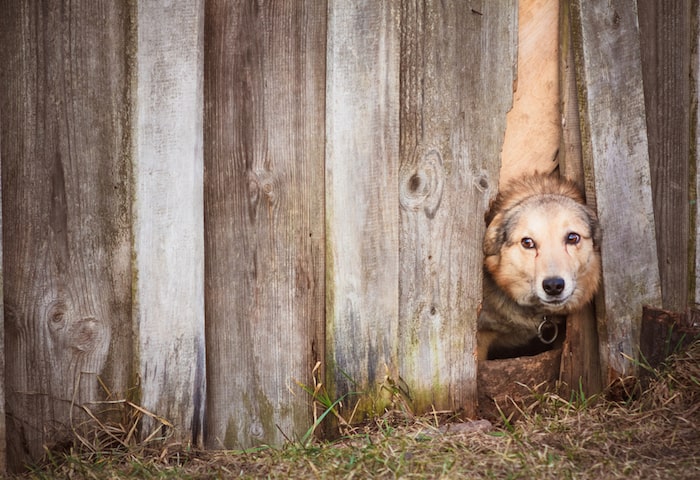
Michael Shikashio is a world expert in canine aggression, teaching seminars to professional trainers around the world on the subject. When discussing preventing attacks with me, he said:
“Situational awareness is crucial when working with dog to human aggression cases. While we set the stage for safety by incorporating protected contact and having defensive tools at the ready, in rare cases, management can fail.
We can often use what is in the environment to diffuse a dog attack. Generally, most dogs will use their teeth on the first thing you put in front of them if they are going to bite. Look around your surroundings as you read this article. What is the closest object you can easily grab and use as a shield? A pillow? A book? A jacket? A leash?
All of these items can be used to “feed” the dog as you make your escape, whether they are biting and releasing or biting and holding. Slowly back away from the dog as you find a doorway, vehicle, or fenced area to separate yourself. Do not scream or run as doing so may escalate the attack. You can also climb on top of something to escape many advancing dogs. A car, desk, or kitchen counter can be areas of safe refuge if the dog is not a good climber. This can buy you valuable time.”
Michael has used everything from clipboards to laptop bags to fill the mouth of a would-be-biter (keeping his arms safe).
Of course, unfortunately, there are times where everything falls apart. Knowing how to read dogs, carrying citronella spray, and avoiding risky situations can help a lot, but it’s no failsafe.
Remember: Most Dog Bites Aren’t Maulings
Keep in mind that the vast majority of dog bites are over quickly.
Almost every time I’ve been bitten (only twice, and both before I was a professional trainer) or seen a bite happen (thousands, if you count videos), the dog bites one or more times in a quick, snappy fashion. Generally, these bites are easy to escape because they’re over as quickly as they started.
The really scary scenarios are the ones where a dog is much more serious about his aggression. Luckily, these occasions are more rare, but they can and do happen. Many of us have seen the horrifying videos of dogs biting and holding, shaking and dragging a human or another dog.
This is an incredibly dangerous scenario, and this is where a bite can turn into a mauling. If a dog isn’t letting go of you or keeps coming after you for more than a few seconds, the situation is very serious.
You need to get something between you and the dog, ASAP.
What to Do if a Dog Attacks You: How to Escape 5 Scary Scenarios
Even if you do everything right, it’s absolutely possible to run into scary scenarios with dogs.
Whether you’ve got a potentially dangerous dog in your home, your neighborhood, or your workplace, it’s smart to know how to handle the situation.
Quick Tips For Any Kind of Dog Attack
We’ll go into detail below about how to handle different attack situations, but in all scenarios, these tips are worth remembering:
Protect Your Hands & Face. No matter where you are or what’s going on, your number one goal is to protect your hands and face. Turning your back on the dog and staying upright is incredibly important because this protects your face, neck, and belly. Even the biggest dog in the world isn’t as much of a threat if you’re standing versus lying down.
If you get knocked over, curl into a ball to protect your face and belly, covering the back of your neck with your hands.
Get Away & Put Something Between You and the Dog. Air horns, citronella spray, and other tools can help, but your number one goal is to get away.
While kicking the dog to keep it away from you is certainly an option, try to focus your energy on getting a non-fleshy object between you and the dog. Kicking or hitting may help, but it also puts your limbs closer to the dog. Additionally, hitting may only heighten the dog’s stress and arousal level, making the dog dig in harder.
Cover the Dog’s Face. Covering the dog’s face with your shirt, a blanket, or a jacket is a good tactic. I’ve seen people throw blankets, tarps, and more at dogs to “disarm” the dog. This can disorient the dog long enough for you to get away.
Now let’s go into more detail about how to handle specific attack situations.
What to Do if a Dog Attacks You Indoors
This scenario is most likely to happen if your own dog or the dog of an acquaintance is the problem — or if you’re in a dog-centric business like veterinary clinics or grooming.
In most situations, you’ll want to get a door between you and the dog. You can slam doors to make a dog let go if it’s got ahold of you.
Otherwise, you can put chairs, laptop bags, pillows, or just about anything else within reach between you and the dog. Striking an attacking dog with an object is probably a better idea than using your feet or hands.
Of course, try to call for help while all this is happening!
Once you and the dog are separated, take care of yourself mentally. Then come up with a game plan — you’ll probably need to remove the dog from where he currently is.
You may be able to use a piece of meat with sedatives if you have access to them inside the home. This will allow you to move the dog into a crate or do what you need to do.
Most animal shelters and veterinary offices will have procedures and tools in place to capture and sedate aggressive animals. Get to a phone and get help if you need to.
What to Do if a Dog Attacks You Outdoors
Outdoors, it’s harder to get a door between you and the dog. That said, you might still be able to get onto the opposite side of a gate, fence, car door, or house.
Call for help and do your best to stay upright. Try not to scream, as this may make you sound like prey.
Attempt to cover the dog’s head with anything you can grab. If you need, hit the dog with an object. If you can’t get an object, hit the dog. Aim for its belly with your feet or for its ears with your fists.
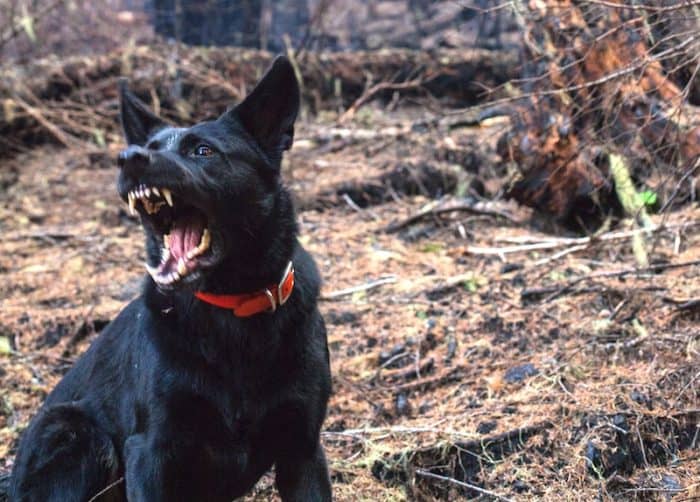
If you break free of the dog, don’t run – back away and try to get something in your hands in case it comes back at you. Then seek medical attention and report the dog.
What to Do if a Dog Attacks You While On Leash
If you’re holding the leash of a dog that’s attacking you, you’ve got a lot of options.
Always start your walk by looping the leash strap over your thumb and hold the leash with both hands near your belly.
I coach all of my clients to walk their dogs this way – it’s more comfortable and safe than wrapping a leash around your hand. This gives you maximal control, especially if the dog is bigger than you. It also allows you to drop the leash if necessary.
Use two handlers and two leashes if you’re worried about a given dog. This allows each person to hold a leash, so if needed, they can pull the dog away from the other handler. Walk the dog between the two people – this method is really only useful for shelter workers.
This is a great option if you’ve got a threatening dog and don’t have a catch pole or other tool designed especially for handling dangerous dogs.
If the dog is actively attacking you, you have two main options for stopping the attack:
- String-ups. These are tricky, so practice using a heavy bag first. This is an emergency defensive move where you essentially yank a dog upwards and away from you (with straight arms), often while you hop backwards. This is not meant to be a correction. It’s a defensive move to get a dog away from you if that dog is trying to hurt you.
- A loop-back. This is my favorite trick for handling aggressive dogs. You can loop your leash around a tree, post, chain link fence, or just about any other solid object. Then you can pull on the leash, which pulls the dog towards that object and away from you.
What to Do if a Dog Attacks A Child
This is of course a nightmare for parents.
If you see a dog attacking a child, call to the child and attempt to give instructions while you approach. Tell the child to “be a tree” and stand still, if she’s still standing. If she’s on the ground, instruct her to roll into a ball.
Make Noise & Use Nearby Objects As a Barrier
Make a lot of noise while you approach the dog — this will scare off most dogs. Use pots and pans, air horns, your voice, or anything else you can get your hands on.
Put something between the dog and the child (like a board) or cover the dog with a heavy blanket. For obvious reasons, we don’t want to use citronella spray or dog pepper spray with a child involved.
If you can simply pick the child up, do it. Then be ready to get up or away immediately. Lifting the child may make the child even more interesting to the dog!
The Wheelbarrow Method
If none of that is working, you may need to use the wheelbarrow method. Grasp the dog firmly by the hind legs (above the knees) and pull the dog away.
This is quite dangerous, as the dog can easily turn to bite you. But if you witness a dog mauling a child, it may be your only option.
Keep in mind that the wheelbarrow method isn’t a good idea to use if the dog has bitten the child and is not letting go. Tugging on the dog may cause more tearing and damage to the child. In a grab-and-hold case, you may need to use a method sometimes called a “forced out.”
Last Resort: Forced Out Method
Let me say now: I do not like this method. At all. But this is an emergency situation.
In essence, you’re going to choke the dog out until it lets go of the child. Lift the dog by the collar, choking the dog until it releases. If the dog doesn’t have a collar, use your belt.
Now, this gets graphic — but some experts suggest hanging the dog by the collar until it passes out, or the dog will resume the attack. Of course, this is incredibly dangerous (for both you and the dog).
Hopefully, you’ll never have to use this method. But it’s important to know all your options in the event of an attack.
What to Do if a Dog Attacks Your Dog
For most of us, this is the most likely way that we’ll get acquainted with dog attacks and dog fights.
Usually, you’ll be able to split the dogs up with noise or citronella spray. In all of my years as a trainer, I’ve only had two fights that weren’t stopped with noise or citronella.
Both of these fights happened were when we were assessing potentially dangerous dogs at the shelter. In both cases, we were able to split the dogs up by pulling apart on the leashes during a break in the biting.
But what if the dogs aren’t both on leash?
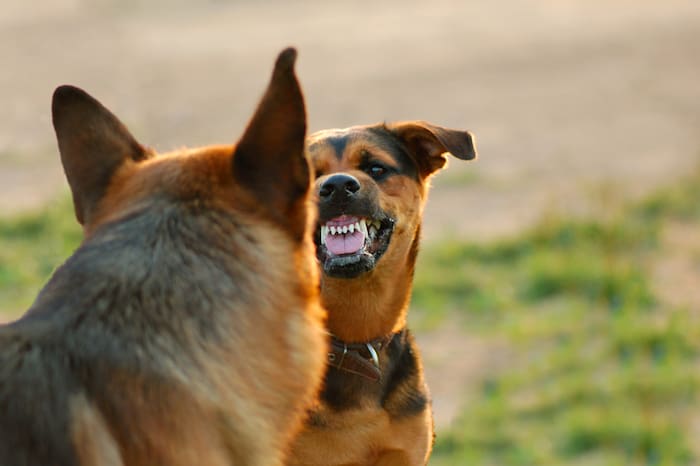
In that case, you’ve got a few options left. Aside from the methods mentioned above (citronella, a heavy blanket, closing doors, or the wheelbarrow method), you can also spray two fighting dogs with a hose, assuming you have one handy.
You can also check out our “How to Break Up a Dog Fight.” article for more ideas and strategies.
I Just Escaped a Dog Attack. Now What?
After a dog attack, there’s a lot to do. The adrenaline is pumping and it’s easy to miss steps, so here’s the general gist of what you should do once the attack is over:
Make sure everyone is OK. Check over yourself and anyone else involved for injuries. Seek medical treatment right away if needed. Ensure the situation is safe or leave the area if necessary.
Exchange information with the owner. Make sure you’ll be able to contact the owner, if you can find them. If you can’t find the owner, document what the dog looked like and where the attack took place. If same, take a photo of the dog and the location.
Document the attack. Before calling the authorities, write down (or use a voice recorder on your phone) what happened in as much objective detail as possible. This will help in the event of legal action. Instead of saying “the dog was obviously aggressive,” say things like “the dog approached with a hard stare, dilated pupils, and a lowered head. It moved slowly at first, with its mouth pulled forward.”
Call the police or animal control. Each jurisdiction has different rules about who to contact in the event of a dog bite or dog attack. The local police or animal control will be able to document your report, or at the very least, direct you to the proper authorities.
Seek medical attention. If the dog bite broke skin, it’s time to go see the doctor. This will ensure that no infections take hold. In the event of a nasty dog attack, you may need far more than just antibiotics. Dog bites can result in nasty stitches or even broken bones.
You may also suffer from PTSD after a dog attack. Seek help from a therapist or counselor if you start developing nightmares or nervous feelings around dogs after an attack.
Depending on the severity of the case, you may be called upon for legal action (or you may want to pursue it). Be prepared with detailed, objective notes from the attack in this case.
Dog attacks are terrifying and – luckily – blissfully rare. It’s generally possible to avoid a dog bite by reading a dog’s body language, diffusing the situation, or spraying the dog with citronella before it attacks.
Have you been attacked by a dog? How did you stop the attack? Share your experience in the comments!





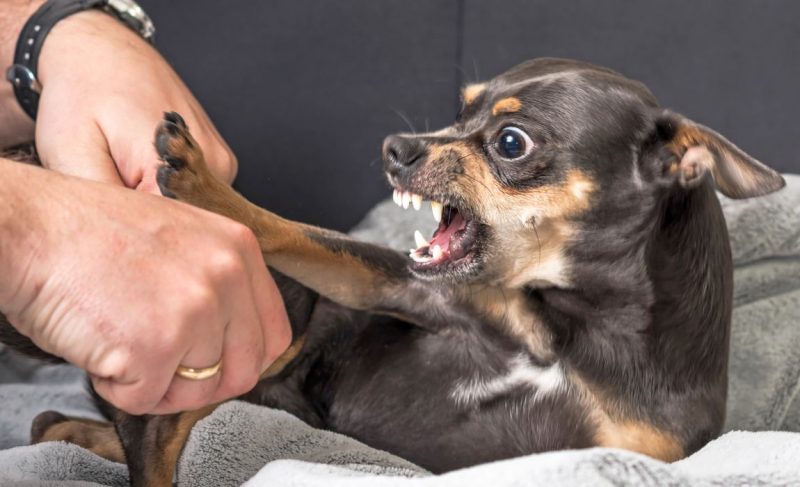
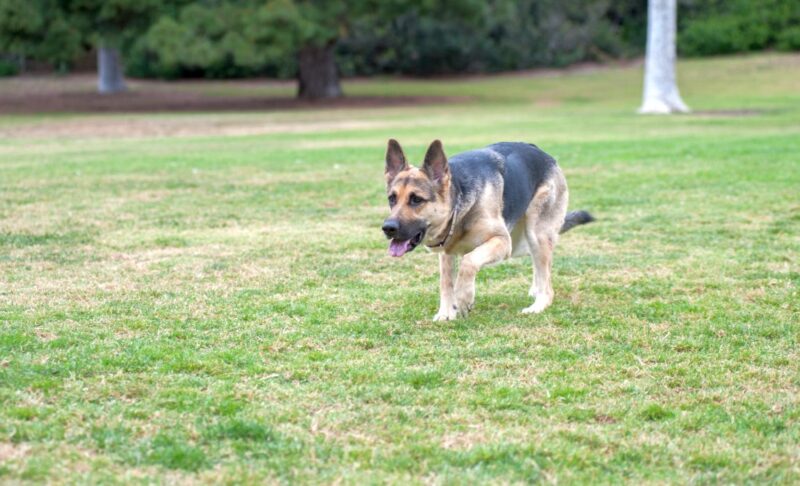
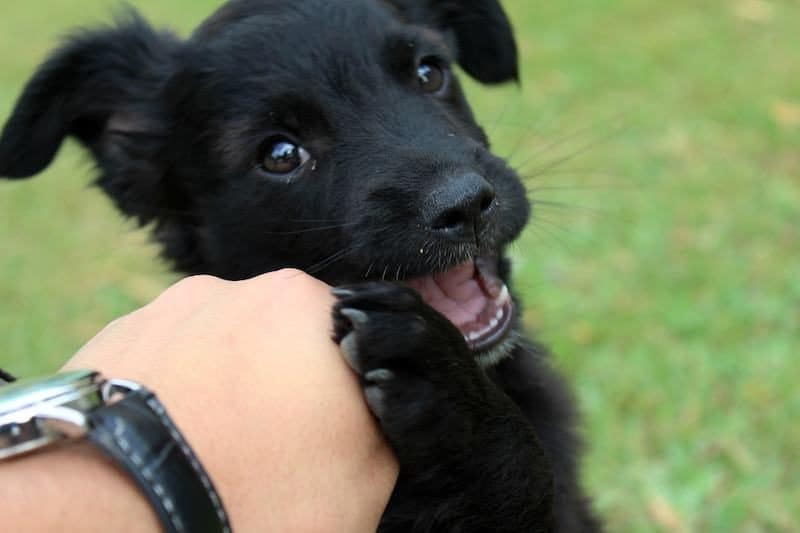

Leave a Comment